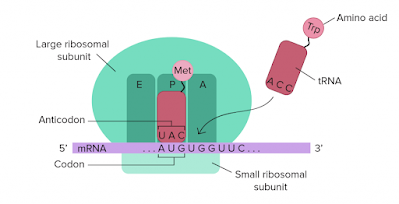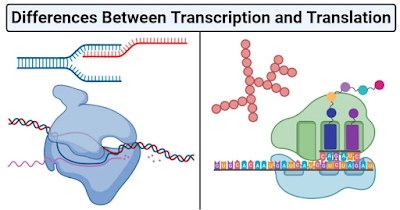DNA Translation - Definition and Process
Definition
DNA translation refers to the process of synthesizing a protein using the genetic information encoded in the DNA molecule. However, it is important to note that DNA itself is not directly involved in the process of translation. Instead, the DNA molecule is used as a template to synthesize an RNA molecule through the process of transcription.
Enzymes involved in Translation
Translation is the process of converting the genetic information encoded in the mRNA (messenger RNA) into a functional protein. This process involves a number of enzymes that play different roles in the process of translation.
Aminoacyl-tRNA synthetases: These enzymes are responsible for attaching amino acids to their corresponding tRNA (transfer RNA) molecules. There are 20 different aminoacyl-tRNA synthetases, one for each amino acid, and they ensure that each amino acid is correctly paired with its corresponding tRNA molecule.
Ribosomes: Ribosomes are the molecular machines responsible for synthesizing proteins. They consist of two subunits, a small subunit and a large subunit, and work together to read the genetic information encoded in the mRNA and use it to assemble a protein.
Initiation factors: Initiation factors are proteins that help to assemble the ribosome at the start codon of the mRNA molecule. They help to ensure that the ribosome is correctly positioned and that the first tRNA molecule is correctly paired with the start codon.
Elongation factors: Elongation factors are proteins that help to add amino acids to the growing protein chain. They assist in the movement of the ribosome along the mRNA molecule and ensure that each new amino acid is correctly added to the growing chain.
Release factors: Release factors are proteins that help to terminate translation when the ribosome reaches a stop codon. They trigger the release of the completed protein from the ribosome and the dissociation of the ribosome from the mRNA molecule.
Overall, these enzymes work together in a complex and coordinated manner to ensure that the genetic information encoded in the mRNA is accurately translated into a functional protein.
Step by step process of Translation
Translation is the process by which the genetic information encoded in the mRNA molecule is used to synthesize a functional protein. The process of translation can be broken down into three main steps: initiation, elongation, and termination.
Initiation: The first step in translation is the assembly of the ribosome at the start codon of the mRNA molecule. This process is facilitated by initiation factors, which help to position the ribosome and ensure that the correct tRNA molecule is paired with the start codon. Once the ribosome is assembled, the process of elongation can begin.
Elongation: During elongation, the ribosome moves along the mRNA molecule, reading the genetic information and adding new amino acids to the growing protein chain. This process is facilitated by elongation factors, which help to move the ribosome along the mRNA and ensure that each new amino acid is correctly added to the growing chain. As the ribosome moves along the mRNA, it reads each codon and matches it with the corresponding tRNA molecule carrying the appropriate amino acid. The ribosome then forms a peptide bond between the amino acid carried by the incoming tRNA and the growing protein chain.
Termination: The final step in translation is termination, which occurs when the ribosome reaches a stop codon on the mRNA molecule. When the ribosome reaches a stop codon, release factors bind to the ribosome and trigger the release of the completed protein from the ribosome. The ribosome then dissociates from the mRNA molecule, and the newly synthesized protein is free to perform its function in the cell.
Overall, the process of translation is a complex and highly coordinated process that requires the participation of a number of enzymes and other factors. By faithfully translating the genetic information encoded in the mRNA molecule into a functional protein, translation plays a critical role in the functioning of all living organisms.
Application of Translation
Translation has a wide range of applications in various fields of science and technology. Some of the important applications of translation are:
Biotechnology: In biotechnology, translation is used to produce recombinant proteins that can be used in the production of drugs, vaccines, and other therapeutic agents. Recombinant DNA technology allows the insertion of genes coding for specific proteins into host cells, which can then be induced to produce large quantities of the protein using the translation machinery of the host cell.
Genetic engineering: Genetic engineering techniques such as CRISPR-Cas9 rely on the translation machinery to cut and paste DNA sequences to create desired changes in the genetic code. These changes can be used to create genetically modified organisms (GMOs) with desired traits or to develop new therapeutic approaches for treating genetic disorders.
Drug discovery: Translation plays an important role in drug discovery by enabling the identification of new drug targets and the screening of potential drug candidates. By understanding the molecular mechanisms involved in translation, scientists can develop drugs that target specific steps in the process, either to enhance or inhibit translation.
Diagnosis and monitoring of disease: Translation can also be used as a tool for diagnosis and monitoring of disease. For example, cancer cells often produce abnormal proteins that can be detected by analyzing the patterns of translation in these cells. By analyzing the translation patterns in cancer cells, doctors can identify specific molecular markers that can be used for diagnosis and monitoring of the disease.
Agriculture: Translation is also used in agriculture to produce genetically modified crops with improved yields, disease resistance, or other desirable traits. By introducing genes coding for specific proteins into crop plants, scientists can manipulate the translation machinery of these plants to produce the desired traits.
Overall, translation is a critical process that plays a central role in a wide range of scientific and technological applications, from biotechnology and genetic engineering to drug discovery and agriculture.
Difference between translation and transcription
Translation and transcription are two different processes that occur in cells during gene expression.
Transcription is the process of synthesizing an RNA molecule using a DNA template. During transcription, the DNA double helix is unwound by RNA polymerase, and one of the strands is used as a template to synthesize an RNA molecule that is complementary in sequence to the DNA template. The RNA molecule that is synthesized is called messenger RNA (mRNA), which carries the genetic information from the DNA to the ribosomes in the cytoplasm, where it will be translated into a protein.
Translation is the process of synthesizing a protein using the genetic information encoded in the mRNA molecule. During translation, the ribosome reads the codons on the mRNA molecule and matches them with the appropriate aminoacyl-tRNA molecule. The ribosome then catalyzes the formation of a peptide bond between the amino acid carried by the tRNA molecule and the growing protein chain. This process continues until the ribosome reaches a stop codon, at which point the protein is released.
In summary, the main difference between transcription and translation is that transcription involves the synthesis of an RNA molecule using a DNA template, while translation involves the synthesis of a protein using the genetic information encoded in the mRNA molecule.
What is the genetic code and how does it relate to DNA translation?
The genetic code is the set of rules that governs the relationship between the sequence of nucleotides in DNA or RNA and the sequence of amino acids in a protein. Each set of three nucleotides, known as a codon, codes for a specific amino acid or a stop signal. During DNA translation, the genetic code is used to translate the information encoded in the mRNA molecule into a specific sequence of amino acids that make up a protein.
What are the key steps involved in DNA translation?
The key steps involved in DNA translation include initiation, elongation, and termination. During initiation, the small ribosomal subunit binds to the mRNA molecule, and the initiator tRNA carrying the amino acid methionine binds to the start codon. During elongation, the ribosome moves along the mRNA molecule, adding amino acids to the growing protein chain as directed by the genetic code. During termination, the ribosome reaches a stop codon, and the protein is released from the ribosome.
What is the role of tRNA in DNA translation?
tRNA, or transfer RNA, plays a critical role in DNA translation by carrying specific amino acids to the ribosome and pairing them with the appropriate codon on the mRNA molecule. Each tRNA molecule has a specific anticodon that matches a specific codon on the mRNA, and a corresponding amino acid that is attached to the tRNA molecule. During elongation, the ribosome uses the information in the mRNA molecule to match the appropriate tRNA molecule with the codon on the mRNA, and to add the corresponding amino acid to the growing protein chain.
Can mutations in the DNA sequence affect DNA translation?
Yes, mutations in the DNA sequence can affect DNA translation by altering the genetic code and potentially changing the amino acid sequence of the resulting protein. For example, a missense mutation can change a single nucleotide in the DNA sequence, resulting in a different codon and potentially a different amino acid in the protein sequence. Similarly, a frameshift mutation can result in a shift in the reading frame of the mRNA molecule, altering the sequence of codons and potentially disrupting the translation process.




